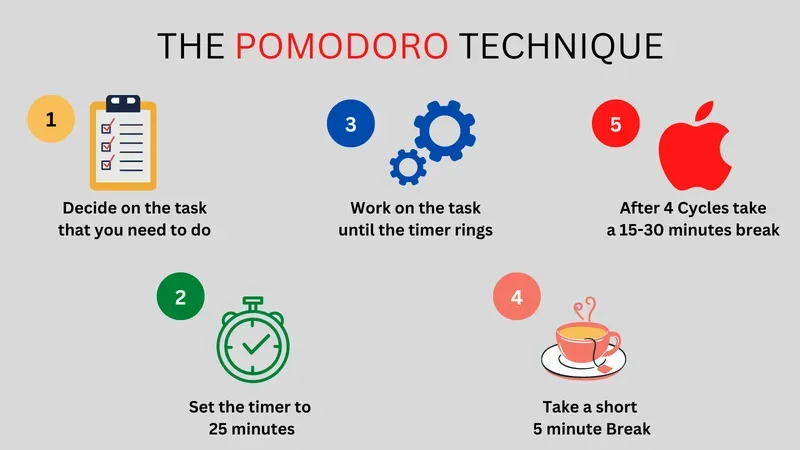

Time management is a crucial skill in today’s fast-paced world, and the Pomodoro Technique has emerged as one of the most effective methods for boosting productivity and maintaining focus. Let’s learn more about this topic below with Snake Game. This simple yet powerful approach has transformed how millions of people work and manage their time effectively.
Developed by Francesco Cirillo in the late 1980s, the Pomodoro Technique is named after the tomato-shaped kitchen timer he used as a university student. The method’s core principle is remarkably straightforward: work focused for 25 minutes, then take a short break. This interval-based approach helps maintain mental freshness and sustained productivity throughout the day.
The technique works by breaking down work into focused 25-minute intervals, called “Pomodoros,” followed by short 5-minute breaks. After completing four Pomodoros, you take a longer break of 15-30 minutes. This structured approach helps combat mental fatigue and maintains high levels of concentration throughout your workday.
Read more: Evening Routines That Save You Hours the Next Day
Research in cognitive psychology suggests that the human brain can maintain focused attention for approximately 20-45 minutes before needing a break. The 25-minute Pomodoro duration falls perfectly within this optimal range, allowing for maximum concentration while preventing mental exhaustion. During these focused sessions, the brain enters a state of flow, enabling enhanced productivity and creativity.
Moreover, the regular breaks prevent decision fatigue and help maintain consistent energy levels throughout the day. The short intervals make tasks feel more manageable and less overwhelming, while the breaks provide necessary mental rest and recovery time. This balance between work and rest is crucial for sustaining long-term productivity.
To implement the Pomodoro Technique effectively, start by gathering the essential tools: a timer (digital or physical), a task list, and a tracking sheet. Begin by listing your tasks for the day and estimating how many Pomodoros each task might require. This planning phase helps create a realistic schedule and sets clear expectations for your workday.
Create a dedicated workspace free from distractions, as each Pomodoro requires complete focus. Turn off notifications on your devices and inform colleagues or family members about your work intervals to minimize interruptions. Remember, a Pomodoro is indivisible – if interrupted, you must start the 25-minute session again.
The breaks between Pomodoros are not just empty time – they’re crucial for maintaining productivity. During the 5-minute breaks, engage in activities that help you disconnect from work: stretch, walk around, drink water, or practice quick breathing exercises. Avoid checking emails or social media, as these activities can easily extend beyond the break time and break your rhythm.
The longer breaks after four Pomodoros are perfect for more substantial activities: taking a proper walk, having a light meal, or doing some brief exercise. These activities help reset your mind and body, preparing you for the next set of focused work sessions.
Many people struggle with the urge to continue working when they’re “in the zone,” thinking it’s counterproductive to take a break. However, these breaks are essential for preventing burnout and maintaining consistent productivity throughout the day. If you’re in deep flow, make a quick note of where you are and return to it after your break – your refreshed mind might even bring new insights.
Another common challenge is handling interruptions. When unexpected issues arise, decide if they truly require immediate attention. If not, note them down and address them during your next break or dedicate a specific Pomodoro to handling such interruptions later in the day.
While the standard 25-minute session works well for most tasks, you can adjust the duration based on your work nature. Creative work might benefit from slightly longer sessions of 30-35 minutes, while intense analytical tasks might work better with shorter 20-minute intervals. The key is maintaining the principle of focused work followed by intentional breaks.
For team projects, coordinate Pomodoros with colleagues to align break times and minimize disruptions. Some teams even use shared timers to synchronize their work-break cycles, creating a collective rhythm that enhances team productivity and collaboration.
Keep a record of completed Pomodoros and tasks to understand your working patterns and productivity levels. This data helps in better estimating task durations and planning future work schedules. Notice which times of day you’re most productive and schedule your most important tasks during these peak periods.
Regular reflection on your Pomodoro practice helps identify areas for improvement. Are certain tasks consistently taking more Pomodoros than estimated? Are particular types of interruptions frequently breaking your focus? Use these insights to refine your approach and increase efficiency.
Read more: 10 Free Tools That Can Help You Manage Time Better
While the original technique used a physical timer, numerous digital tools now support the Pomodoro method. These apps often include features like task tracking, progress statistics, and customizable work-break intervals. Choose tools that enhance rather than complicate your practice, keeping the core principle of focused work periods simple and effective.
Many productivity apps also integrate with project management tools, allowing you to track Pomodoros alongside project timelines and deadlines. This integration helps in better project planning and resource allocation while maintaining the benefits of the Pomodoro approach.
The Pomodoro Technique offers a structured yet flexible approach to time management and productivity. By breaking work into focused intervals with intentional breaks, it helps maintain high levels of concentration while preventing burnout. As with any productivity method, success lies in consistent practice and personalization to fit your specific needs and working style. Start with the basic framework and gradually adapt it to create a sustainable system that enhances your productivity and work-life balance.